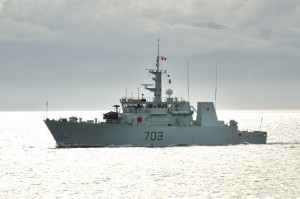
By Enko Koceku
The Canadian Forces Naval Reserve (CFNR), with its headquarters in Quebec City, is the primary Reserve component of the Royal Canadian Navy (RCN). The Naval Reserve employs around 4,000 citizen-Sailors, 35 percent of whom are women. The Reserves are divided into 24 naval division spread throughout the country, which act as hubs for Reservists.
The history of the CFNR actually begins with the Royal Naval Canadian Volunteer Service (RNCVS), established in 1914 during the WWI. The initial mandate of the RNCVS created three sub-commands, each responsible for a third of Canada. During WWI, around 8,000 men enlisted for service either at home or abroad through the RNCVS. By the end of WWI the RNCVS had risen to prominence, but was soon neglected once peace had been established. The Reserve was in a precarious situation because of a significant lack of funding. Reservists ultimately had to pay for their own uniforms and were not paid for their weekly muster and drills.
In the end the RNCVS fell apart due to financial strains, but was soon replaced in 1923 by the Royal Canadian Navy Volunteer Reserve (RCNVR). The organization’s commander, Rear Admiral Walter Hose, thought that the establishment of a robust reserve force would be a strong method of building popular Canadian support for the fledgling Canadian Navy. Rear-Admiral Hose authorized the creation of Naval Reserve Divisions in every major Canadian city.
Like its predecessor, the RCNVR quickly rose to prominence during the outbreak of war. The organization was heavily used by the government of Canada to recruit and build the navy during World War Two (WWII). At its peak the Royal Canadian Navy exceeded 100,000 men, with over half belonging to the Reserves.
The Canadian Forces Naval Reserve was officially formed in 1968 as part of the Maritime Command during the amalgamation of the Armed Forces. Aside from providing manpower for the RCN, the CFNR also crews Canada’s 12 Maritime Coastal Defence Vessels (MCDVs). The Kingston-class ships were originally designed for minesweeping, but have been refitted for patrol and various multi-role duties. Aside from their capability to wage war, Reservists are heavily involved in their community.
Naval Reserve Divisions frequently hold community events and initiatives such as holiday celebrations or fundraising campaigns for charities. Naturally, they are also deployment ready during provincial emergencies such as the Red River floods in Manitoba or the forest fires in British Columbia. The Naval Reserve Divisions themselves provide valuable employment opportunities to locals.
The CFNR, however, is a constant target for funding cuts. While the Canada First Defence Strategy advocates for an increase in the number of total Reservists from 26,000 to 30,000 by 2028 in order to meet future challenges, there’s a certain level of uncertainty regarding the future. It remains to be seen if this policy in fact increases the number of Naval Reservists.

In July 2010, a Canadian Forces spokesperson stated that the fleet of MCDVs would be cut in half, and that there would also be a 50 percent cut in training. The order was soon rescinded however, by outgoing Chief of Defence Staff Walter Natynczyk stating that the Reserves “do a great job” and that “we’re actually growing the Reserves.”
The defence policy also has yet to specify any replacements for the aging Kingston-class ships the Naval Reservists use to patrol Canada’s coasts. However, a commitment to new frigates and destroyers based on a common hull design for the Navy, coupled with the numerical increase in Reservists suggest that the Naval Reserve’s MCDVs could potentially be replaced by a variation of the Navy’s upcoming frigate.
While it is clear that a certain level of difficulty lies in the future for the Naval Reserves, it is not for lack of ability. The CFNR has a tradition of service excellence, as exemplified by LT Robert Hampton Gray, a reservist from Nelson, British Columbia, who served with the Royal Navy’s Fleet Air Arm. His citation for Canada’s last Victoria Cross of the war stated:
“The KING has been graciously pleased to approve the award of the VICTORIA CROSS for valour to: – the late Temporary Lieutenant Robert Hampton GRAY, R.C.N.V.R., for great valour in leading an attack on a Japanese destroyer in Onagawa Wan, on 9 August 1945. In the face of fire from shore batteries and a heavy concentration of fire from some five warships Lieutenant Gray pressed home his attack, flying very low in order to ensure success, and, although he was hit and his aircraft was in flames, he obtained at least one direct hit, sinking the destroyer. Lieutenant Gray has consistently shown a brilliant fighting spirit and most inspiring leadership.”
A memorial was erected at Onagawa Bay, Japan, in 2006, to honour Lieutenant Gray’s heroism. It stands in solitude, the only memorial dedicated to a foreign soldier on Japanese soil.
Despite Canada’s history of frequently defunding the Reserves, the mission in Afghanistan demonstrated the value of a robust Reserve force.
This article was posted with permission from the Atlantic Council of Canada.

